CAA News Today
Staff Interview: Fernando Zelaya
posted by CAA — April 24, 2017
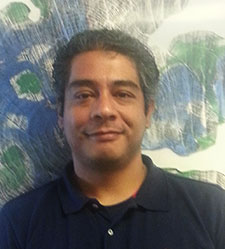 The next in a series of interviews with staff members is a conversation with Fernando Zelaya, CAA controller.
The next in a series of interviews with staff members is a conversation with Fernando Zelaya, CAA controller.
How long have you worked at CAA?
I have been at CAA since December 2012—four years, four months.
What do you do at CAA?
I am the controller, in the Finance Department.
What does CAA mean to you?
CAA to me is a medium for all art scholars to come together and be a part of a community. It’s also a place to share with each other, and to teach each other.
Can you talk about one of your favorite member moments?
Since I interact with members mostly at the conference, I’ll tell one story here and add another in the conference question later on. My favorite member moment was when I helped an elderly member who reminded me of my grandmother. She had such vigor and enthusiasm and seemed genuinely happy to be at the conference. That made my day.
What do you like best about the arts and working in the arts?
What I like best is meeting and working with artists. In my daily life and my earlier years, I had never interacted with artists. Now, having worked for the Dia Art Foundation as well as CAA, I have learned to appreciate art more than I used to, because now I better understand the meaning behind the art.
Do you have a favorite moment from the Annual Conference?
Once at registration I was berated by a flustered member who was late to a session and wanted to get his ticket quicker than was possible. The nice moment came when he returned to my booth after the session was over and gave me a sincere apology.
People interested in art can sometimes rebuff things like sports. But you’re interested in sports like soccer and baseball. Do you see a conflict?
I think that art and sports have more in common than people think. Both require years of hard work to perfect, and both need a combination of grace and power to achieve the objective of the piece (in art) or to score (in a game). It takes grace to stop a soccer ball or save a shot coming toward you at fifty to sixty miles per hour, or to hit a baseball with a bat when both objects are about three inches wide. That kind of skill, to me, is just as beautiful as a stroke of a brush or a poem that can draw a tear or bring about a smile.
You’re also interested in science fiction. Are there any new television shows or movies that have piqued your interest?
Science fiction is my favorite type of television show or movie. My favorite is Doctor Who, because of its sheer brilliance and how it has evolved over the last fifty-three years. The series even survived being off the air, only living in print and audio for almost ten years. The best new show I have seen this year is The Man in the High Castle, which takes us to a world where the Axis powers won WWII and have divided the United States among them. I am also a big fan of the Marvel and DC movies. I love these types of shows or movies because it is fun to immerse myself for a couple of hours—okay, maybe more than a couple—and go somewhere magical or even quite insane.
Staff Interview: Alyssa Pavley
posted by admin — February 10, 2017
The next in a series of interviews with staff members is a conversation with Alyssa Pavley, CAA associate editor of digital publications.
How long have you worked at CAA?
Six years.
What do you do at CAA?
I work in CAA’s Publications Department, where I started out as the editorial assistant. I am currently the associate editor for digital publications and work closely on Art Journal Open.
What does CAA mean to you?
To me, CAA is a place of creative and intellectual exchange.
Can you talk about one of your favorite member moments?
One of my favorite member moments was at last year’s conference in DC, where I had a great conversation with a member who had recently joined CAA and was attending the Annual Conference for the first time. It was fantastic to be able to speak at length with her about her experience, the sessions she had attended so far and those she was looking forward to, and her career. It’s always fun to hear from someone experiencing the Annual Conference for the first time!
What do you like best about the arts and working in the arts?
It’s wonderful to work in such a creative environment. Since I work specifically in arts publishing, it’s great to be in a space where I can help others peruse their artistic and creative passions via digital publications.
Do you have a favorite moment from the Annual Conference?
It’s great when I’m able to help a conference attendee, even if it’s something as small as giving directions to the room where their next session is taking place or looking up the time a session starts—it’s nice to think that I’ve possibly made someone’s day a little less stressful! On a personal note, I love browsing through the Book and Trade Fair.
Hunter O’Hanian Welcomes you to CAA 2017
posted by admin — February 06, 2017
A message from CAA Executive Director Hunter O’Hanian about the 2017 Annual Conference
Greetings,
I am very much looking forward to my first Annual Conference as CAA’s new Executive Director. I think the Annual Conference Committee has done a great job presenting an amazing lineup of sessions and the CAA staff has worked hard to make sure that this will be one of the best conferences ever. Many thanks to Tiffany Dugan, Paul Skiff, Katie Apsey and the rest of the Annual Conference staff who have put in so many hours.
But we also need your help at the Annual Conference.
I’d like every attendee to think about three central ideas which will make the experience more rewarding for you and your fellow attendees.
Create an atmosphere of Inclusion – We’ve heard from past participants that they have not always felt welcome by other CAA members. Some have said that they felt marginalized due to their age, experience, or even the color of their skin. Others have said they felt somewhat judged by other CAA members based solely upon what is printed on their name badge.
Obviously we do not want any CAA member to feel this way. While the CAA staff and board will work to make everyone feel welcome and included, we ask they you do the same. Extend your hand and say hello to a stranger. Say hi to the person sitting next to you at a session. Chat with someone new in the elevator or in a coffee line. Together, we can work to make all of our members feel included.
We want to solve your problems – This year there will be more than 4,000 people in attendance at the conference. In essence, we will be creating a small town at the New York Hilton Midtown for the week. Inevitably, problems will crop up – and we want to solve them.
If you find you are having problems with membership, registration, locating information, please look for one of the CAA staff members wearing the “Ask Me!” button. They will try to quickly understand the issue and get you to someone who can resolve it as soon as possible. We are here to help and that’s what we intend to do!
We want your feedback – Building a CAA for the 21st century is the most important work ahead of us. We cannot do that without hearing what you need to help you in your respective professional fields. We need to hear from you. If you completed the recent survey, many thanks. Those results will be processed shortly.
The field and the organization is changing rapidly and we cannot strengthen it properly without hearing what you need and want. We encourage you to vote in the election for the new board of directors, either on the CAA website or on the CAA Annual Conference App. We encourage you to attend the myCAA session on Friday, February 17, 2017 at 12:15PM. If you cannot attend the session, email us noting a few things that you appreciate about CAA and a few things you would like to see improved. Or leave your comments on CAA Connect in the myCAA Discussion Community. What are the current benefits you value and what benefits would you like to see us add in the future?
Many thanks for taking the time to think about these key messages and I look forward to seeing you at the Annual Conference.
Best,
![]()
Hunter O’Hanian
Executive Director and Chief Executive Officer
myCAA Post-it Wall
posted by CAA — January 20, 2017
The myCAA Post-it Wall, located near registration on the Hilton’s second floor, is where attendees can post their notes, scribbles, messages, heartfelt missives, and anything else they feel like sharing on a myCAA Post-it. The myCAA Post-it pads will be easy to find and pick up around the conference. Get yours at CAA’s booth in the Book and Trade Fair, in the registration booth, or at the hospitality booth.
Hospitality Booth
posted by CAA — January 19, 2017
At the New York conference you will find a hospitality booth, where CAA staff and conference help will be stationed to answer questions about sessions and the Book and Trade Fair, or for directions to the restrooms, the lactation room, or the quiet room. Located on the second floor of the Hilton near the registration area, the hospitality booth is intended to make CAA members feel welcome at the conference. The CAA team will also be filming interviews with members at the hospitality booth.
Staff Interview: Katie Apsey
posted by CAA — December 19, 2016
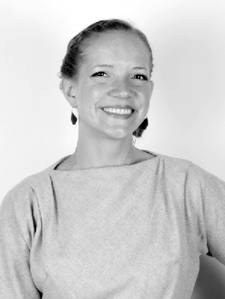
Katie Apsey
The next in a series of interviews with staff members is a conversation with Katie Apsey, CAA manager of programs.
How long have you worked at CAA?
I have worked at CAA just over one year now. I originally started in the Publications Department as data coordinator for the graduate-school directories and moved over to the Programs Department when Lauren Stark left her position to pursue work in the archives field.
What do you do at CAA?
Many different things! I do the administrative work for all programs related to the conference: session submissions for the Annual Conference Committee’s review, ARTexchange applications, submissions to the various conference publications and the conference website, special events, business meetings, poster sessions, appointments for mentoring sessions, and more! I also help the juries for the annual Awards for Distinction as well as the conference travel grants. Both are quite rewarding.
What does CAA mean to you?
I became a member of CAA long ago when I graduated with a BA in photography and was searching for my first job. At that point in my career, membership was a way for me to determine the state of the field—what kind of jobs and opportunities and career paths there were for me as a young artist. As my career shifted away from art practice and toward museum work and then art history, CAA became a network for keeping up with peers rather than a resource for the job market.
Can you talk about one of your favorite member moments?
It would be too hard to pick one moment of engagement with a member. While working in the Speaker Ready Room I overhear amazing conversations between session chairs and their speakers while they prepare before or recombobulate after their sessions. Observing the uniqueness of each group and noting the different approaches that session chairs take when creating thoughtful panels is equally inspiring. I always learn things about new theories, historiographies, artists, and exhibitions through osmosis while I am running around doing management tasks!
What do you like best about the arts and working in the arts?
This sounds so cliché, but I like being surrounded by creative people and getting inspired and challenged by them: people who know that the “right” or “best” answer is an ambiguous, moving target; people who, after they are done with the business of an email, send me a link to an article, exhibition, or artist’s webpage; people who know the value of thinking deeply or uniquely; and people who do what they do not for the money but for their belief in the importance of discourse.
Do you have a favorite moment from the Annual Conference?
When I attended as a regular member, my favorite moments were seeing my academic heroes speak or listening to the annual Distinguished Artist Interviews. Now that I work for CAA “behind the scenes,” my favorite moments have become working with the room monitors onsite. These are the people that check conference badges at the doors to session rooms. I enjoy hearing what they are working on with their art or scholarship, pointing them toward sessions they may have overlooked in the program, and taking in the stories of the retired professors who are volunteering their time.
You are writing your dissertation on Native American art, and the CAA office is up the street from the Smithsonian Institution’s National Museum of the American Indian (NMAI). Have you visited the museum often since working here?
Yes, I feel very lucky to be so close to the museum’s New York branch. One of the main curators there, Kathleen Ash-Milby, is a powerhouse who focuses on contemporary Native American art, which is what I write about most often, so I value seeing the exhibitions at the George Gustav Heye Center as soon as they open. The museum also has the film and media center with rare digital content and a cozy educational library that I like to visit on my lunch break. It is the perfect spot for even fifteen minutes of reading outside the office, or for watching a VHS tape from the NMAI collection of performances that hasn’t been digitized yet! A lot of tourists visit lower Manhattan, but many of them don’t know they can go inside the Customs House—the building that houses the museum—for free, so it still remains a quiet refuge with rotating exhibitions and frequent nighttime events. In fact, I attended a MuseumHue event there about art and social change just a few weeks ago!
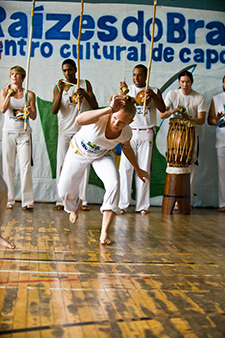
Katie Apsey practices the Brazilian martial art of capoeira (photograph provided by Capoeira Vida)
You have performed and taught dance. What are your specialities and favorites?
Oh, I could go on for hours about this. I love whatever classes I can take. As a company dancer, I felt like contemporary dance challenged me the most intellectually. It really pushes the boundaries of expansive concepts like “movement,” “performance,” and “choreography.” Closer to my heart, though, are samba dance and the Brazilian martial art of capoeira, both of which feed my soul. Samba is physically demanding yet joyful and amazingly fun to perform. I love looking into the crowd from the stage and seeing hundreds of people smiling back or even dancing themselves because they can’t sit still. Conceiving of and making new costumes uses my creativity in a different way.
There are many types of samba—including carnival mas group/Rio-style samba, Bahian-style samba de roda, and Orisha dances associated with Candomblé—that speak to different needs, abilities, histories, lives, and energies. Dance is an art form that grows with a person over time and answers their needs in the moment. Capoeira is the same way. It is actually a martial art, not dance. It challenges both my body (I swear someday I will still be able to learn a back flip … in my thirties) as well as my mind (in the strategy of the game). Capoeira even challenges my musical abilities in having to learn all the songs and instruments while trying to sing in tune!
Your Support Is Vital to the Arts
posted by CAA — December 02, 2016
 Imagine our world without culture.
Imagine our world without culture.
In today’s economy-driven society, it is easy to imagine a world where our past and present cultural history is ignored—or even worse, destroyed. We see educational systems focused more on science and technology and less on the arts and humanities, with art department budgets slashed and employment opportunities shrinking while student debt is rising to an all-time high and our collective historic cultural past is destroyed in the Middle East and other parts of the world.
That’s why the College Art Association is important. For more than a century, CAA has been the preeminent international leadership organization in the field of visual arts. We strive to create an environment where visual artists, art historians, designers, museum professionals, critics, and scholars successfully and freely create and prosper in their professional fields. We do this because we know if these professionals prosper, our culture will not only be preserved, it will thrive.
We ask that you join us in celebrating CAA’s rich history and prosperous future by making a tax-deductible gift to the organization. Your support goes directly to the programs we offer.
Register now for the 2017 Annual Conference, February 15-18 in New York. The Early Registration deadline is December 19.
Together, we can ensure that our culture is preserved.
Sincerely,
![]()
Hunter O’Hanian
Executive Director and Chief Executive Officer
CAA Restatement of Values, November 2016
posted by CAA — November 22, 2016
For more than one hundred years, the College Art Association (CAA) has been dedicated to the creative process through making and thinking about art and how it affects our past, present, and future. We do this through scholarship, publications, convenings, research, and professional development for artists, designers, and art historians. As a member-driven association, we are committed to intellectual rigor, peer review, inclusion, and diversity. We uphold these values by engaging everyone, nationally and internationally; all races, ages, abilities, religions, citizenships, ethnicities, gender expressions, and sexual orientations. We defend academic freedom as forcefully as we reject discrimination, bigotry, sexual assault, and violence against the vulnerable.
As scholars, artists, and educators, we expect the same exactitude from leaders in education, cultural institutions, and, in particular, government. We will continue to advocate in no uncertain terms for an inclusive climate that fosters intellectual honesty, transparency, and human engagement.
Suzanne Preston Blier

Executive Director
Hunter O’Hanian

Staff Interview: Doreen Davis
posted by CAA — November 21, 2016
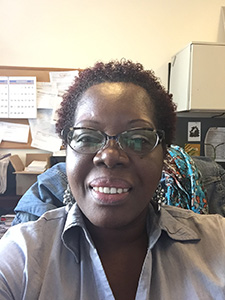 In our first staff interview, we spoke with Paul Skiff, assistant director for Annual Conference. Continuing in the staff interview series, we spoke with Doreen Davis, who currently holds the record for longest-serving CAA staff member.
In our first staff interview, we spoke with Paul Skiff, assistant director for Annual Conference. Continuing in the staff interview series, we spoke with Doreen Davis, who currently holds the record for longest-serving CAA staff member.
How long have you worked at CAA?
Twenty-six years.
What do you do at CAA?
I am the manager of member services.
What does CAA mean to you?
CAA has many meanings, but the greatest meaning to me is that it represents the opportunity for me to grow, for me to share what I have learned, for me to plant the seed of possibilities and leave behind a bigger, better organization than the one I first started working for. CAA will always be the organization that challenged me to be better and to have the flexibility to make our members feel that we are not just an organization. We are their partner for as long as they are members, whether active or lapsed.
Can you talk about one of your favorite member moments?
One member was very dissatisfied on several occasions and continued to be very mean on the phone. Even after I resolved her membership issues, she did not say “thank you” but instead hung up. The conference was approaching, and I am usually stationed at the “Problem Information Booth.” I hoped and prayed that I would not see her at the conference, because she would definitely come to that booth. Well, I was not so lucky. She showed up and, after reading my badge, said, “Hi Ms. Davis, I am so and so. I want to apologize for my behavior—it was so unlike me. I was going through a rough period, but thank you for your patience and your help.” I responded, “You are very welcome, and enjoy the conference.” Whew!
What do you like best about the arts and working in the arts?
I love that art can transcend time, and if art is good it will last forever. I also love that we can have an unlimited number of interpretations of art. Everyone sees or hears roughly the same thing, but each of us has our own opinion of it. Our experiences in life help shape our opinions of art. No two people experience the exact same thing, so our interpretations are bound to vary. I love working for the arts because I see how my efforts positively affect people in need. Nonprofits are a great place to maximize your mental talents along with your compassion.
Do you have a favorite moment from the Annual Conference each year?
One of my favorite moments was encountering a job seeker who had an interview, but because she was not a current member she was not allowed in the Interview Hall to meet with the employer. I gave her an individual-membership brochure with an application and walked her into the hall. She took it and thanked me. I said to myself, maybe she will join. She came back later and informed me that the interview went well. I said, “Congrats!” I forgot all about her until a few months later, when she sent me an email telling me she had been hired. Because of that, she took out a membership!
Staff Interview: Paul Skiff
posted by CAA — October 27, 2016
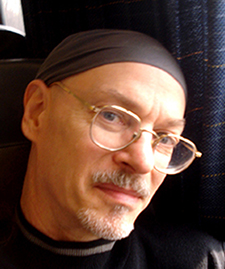 Paul Skiff
Paul SkiffAs part of the new myCAA campaign where we ask our members to share with us what CAA means to them, we thought it also makes sense to share with our members more about ourselves at CAA. In this spirit, every few weeks we will post an interview with a staff member at CAA. We want our members to know who we are also.
Our first interview in the series is with Paul Skiff, assistant director for Annual Conference.
How long have you worked at CAA?
Seventeen years.
What do you do at CAA?
I handle all space use for the Annual Conference: facility specification and coordinating with facility personnel, logistics, service providers, production, marketing, and sponsorships for the Book and Trade Fair, receptions, tours, onsite direction, and the task of working up budgets for all of this. Essentially I set up the arrangements that enable us at CAA to coordinate everyone and everything into and out of the conference.
What does CAA mean to you?
CAA is a leading international organization promoting visual art and culture in a way that has direct impact on society. The conference brings together the membership, along with related professions, for a large public event that gives a high profile to the cultural sector of the host city and contributes to defining the forward direction of culture in general.
Can you talk about one of your favorite member moments?
Too many to mention, really. CAA members are so frequently a great pleasure to work with no matter what the situation. At its base the organization is a collective, and that really guides so much of what members bring.
What do you like best about the arts and working in the arts?
Art, and culture in general, provides a basis for unity across social, cultural, national, and political boundaries. In the urban culture of the United States, cultural practice is seen as an open forum with authority to comment upon—and provide a way for coping with—the prevailing conditions of the time. Applied this way, cultural practices have as their main goal establishment of a democratizing equality. What I like about one part of the particular work I do in the arts with CAA is that my efforts serve to create opportunities for thousands of people involved in art and culture. Over my time working with CAA, this has amounted to providing a wide variety of opportunities for literally tens of thousands of people involved with art and culture.
Do you have a favorite moment from the Annual Conference each year?
The closing celebration for department staff after sessions conclude on the last day of the conference, when a year’s worth of hard work is complete and you know thousands of people had a pleasurable and fulfilling experience.
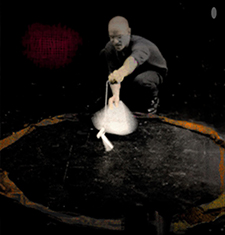 Video capture of Paul Skiff’s performance Blood Circle
Video capture of Paul Skiff’s performance Blood CircleWhat have your most recent performances consisted of?
My most recent performances have been straightforward presentations of texts and poetry spoken live, often with supplemental sound, and mostly presented for community-based cultural organizations with a vision for preserving, promoting, and strengthening local culture.
How do you feel about the differences between your art performed live or recorded on tape?
My live performance often incorporates recorded sound and images, so it is not that easy to separate the two modes of presentation. But to consider electronically recorded material separately, there is of course a vast difference with regard to the resultant sensory phenomenon. The main strength of actual live, spoken work is its generative quality, its immediacy, and its ability to create a “hearership” that can challenge existing listening institutions. With electronically recorded sound and/or images you have the rather endlessly deep toolbox of technology, which mostly amounts to applying exaggeration and distortion to live forms, and playing with time, as well as simply preserving information for transmission. I’m not saying anything profound by that, of course. Applying technology to a live performance enables an extension and transformation of form that allows for many different and new ways to present the work, seek a broader audience, and invent ever more creative solutions.
The creation of electronic information along with storage and retrieval is the most expansive creative environment for us now. At this point in our history telelectricentrism is second nature. Humanity has adapted to this so that forms of experience based on electronic image and sound increasingly dominate everyday life. We are still discovering how this is an asset and liability. It has mixed results and risky implications for our ability to really communicate. But in this for me is a great and absorbing task of applying these distorting and exaggerating technologies to instill acts of rehumanizing our culture. It’s kind of like taking something inherently dangerous and reshaping or repurposing it to provide pleasure, fulfillment, and a greater sense of shared well-being—not to mention preserving and strengthening our sense of self-worth.


